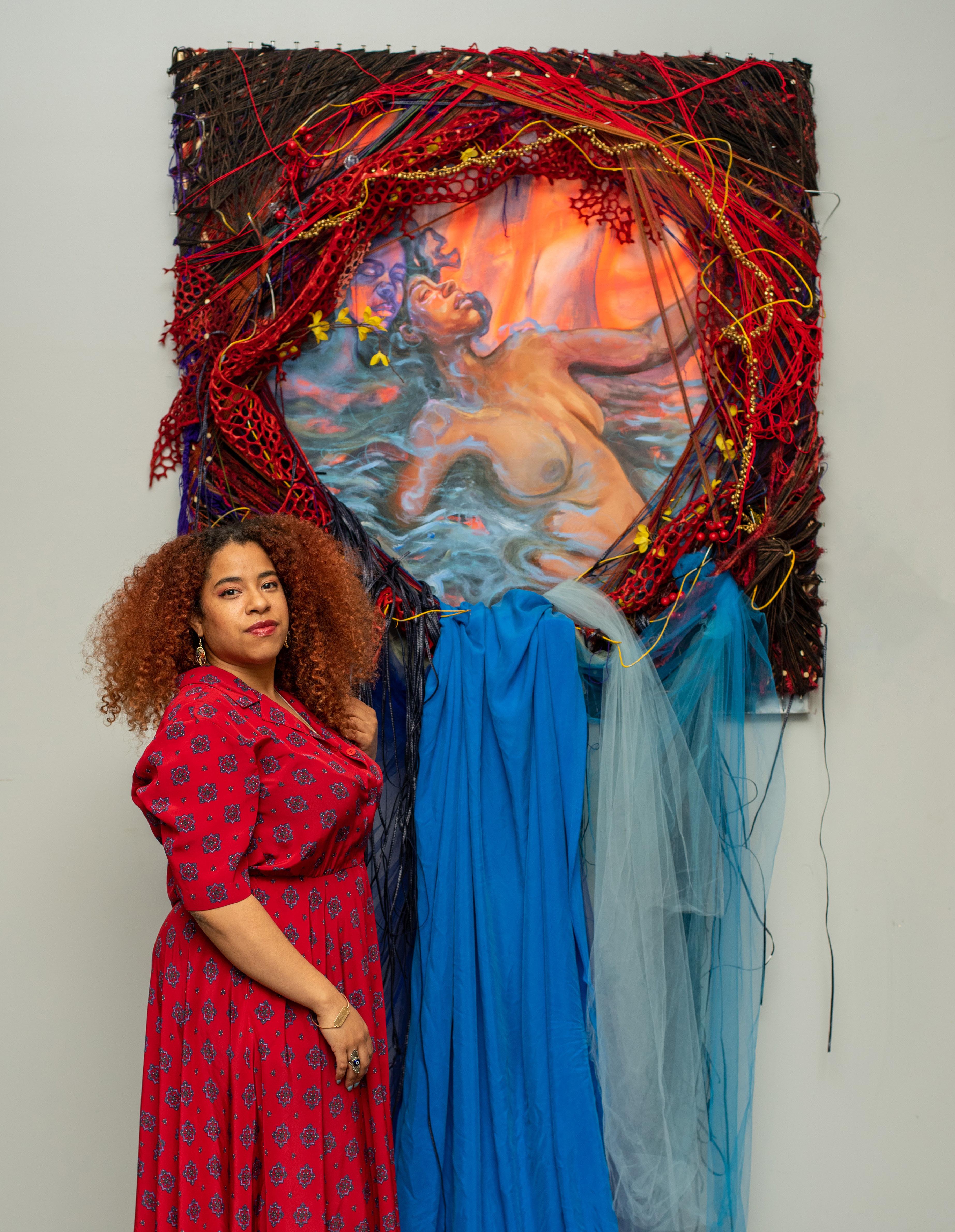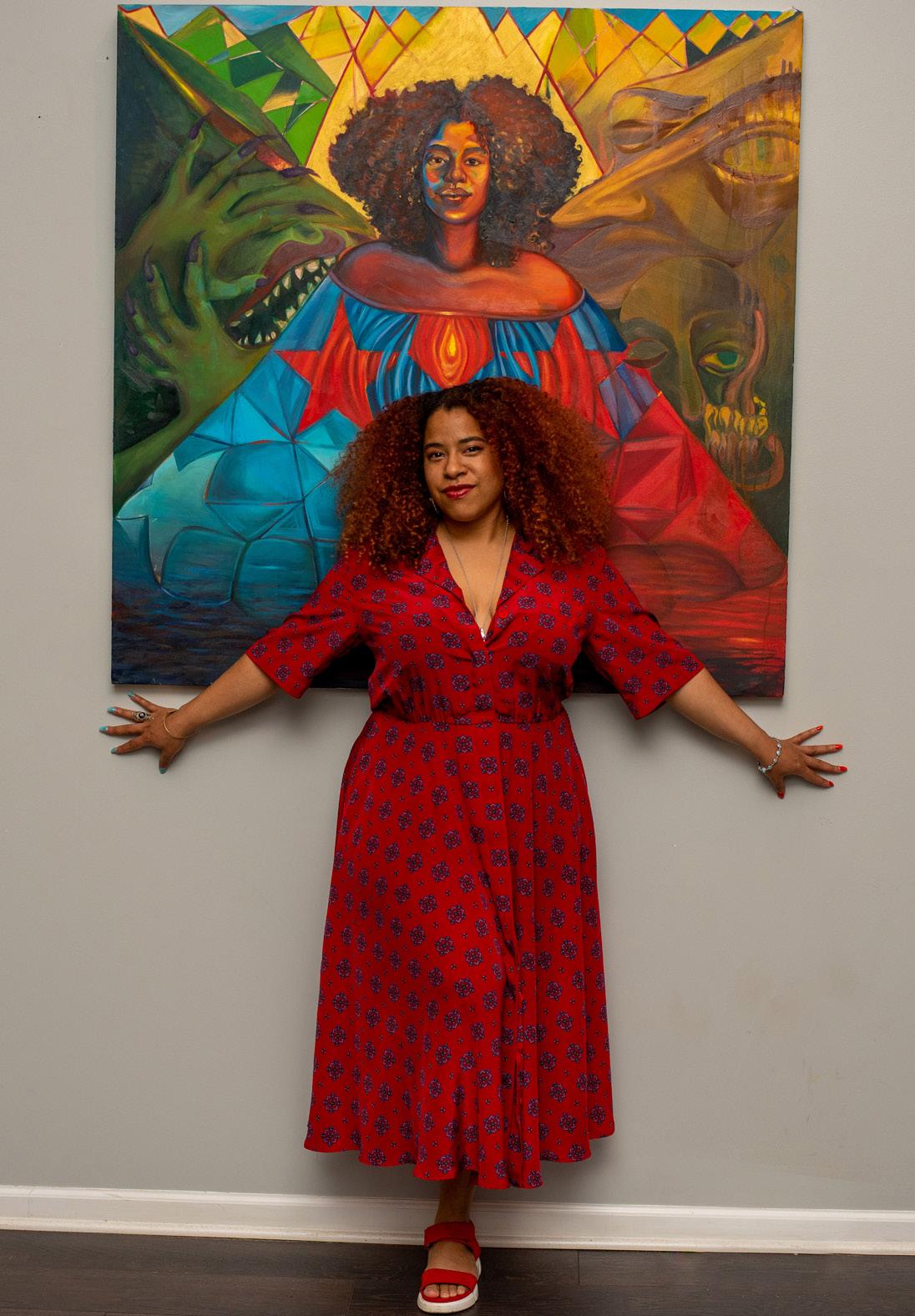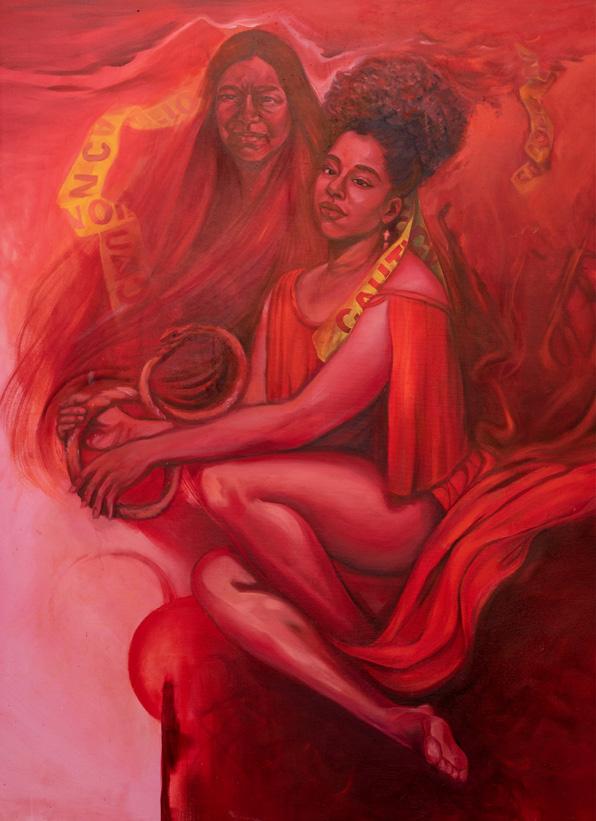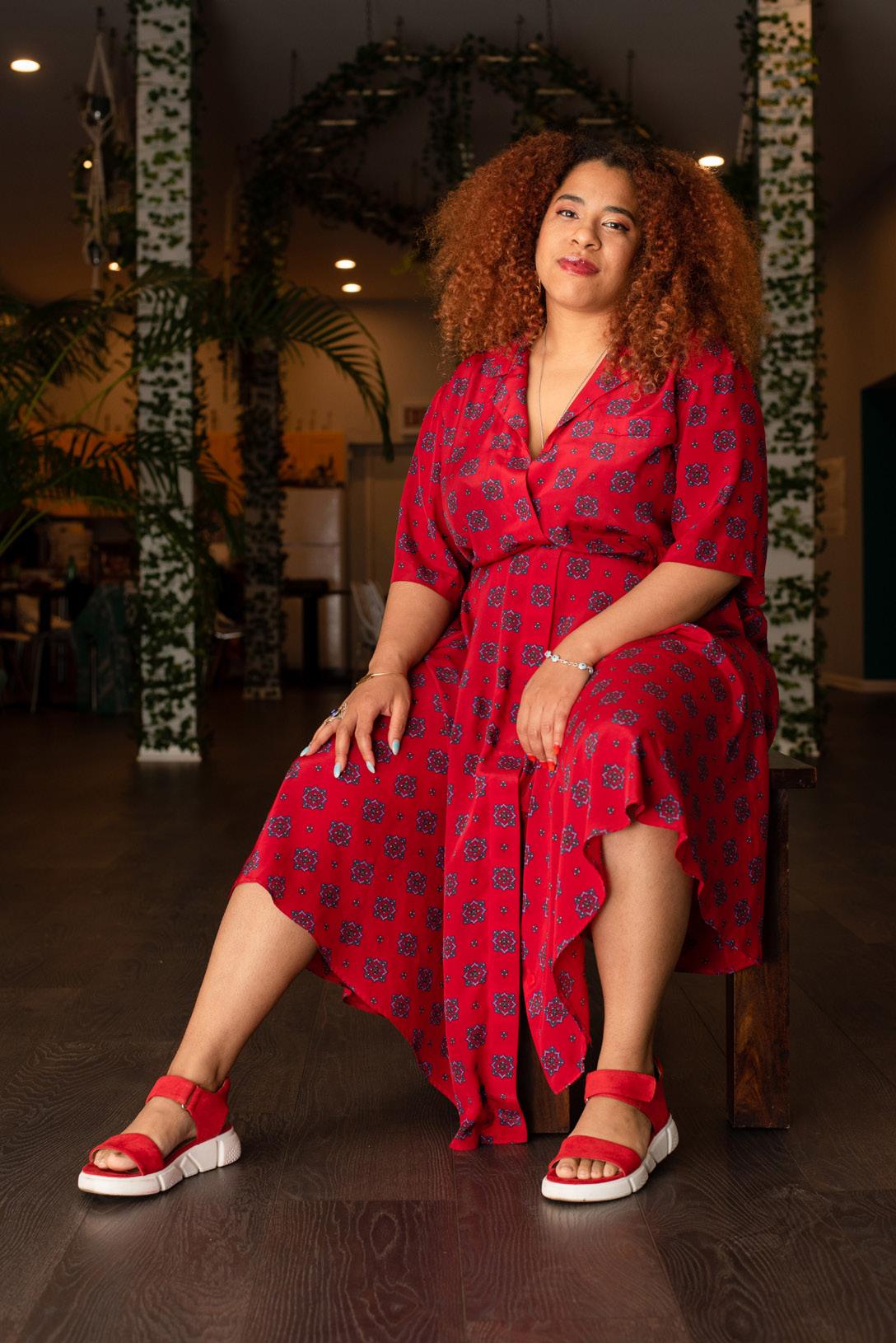
9 minute read
LIZ GOMEZ ON ART, CHICAGO AND HOLDING SPACE FOR EACH OTHER
from ROC June 2021
In a recent phone conversation, we learned how artist Liz Gómez began their professional art career and the ideas that give way to thought-provoking pieces and concepts displayed in bold colors across different mediums. Their work advocates for self-love and introspection, for taking care of one another and the planet we live on. Ultimately, they hope their work serves as a way to share the “range of representation of Black, Indigenous, and People of Culture.”
From screen prints and abstract pieces (The Joy of Freedom) to portraiture (Divine Gratitude Portrait Movement), among some of these series, Gomez’s creations exude healing, pride, love, and resistance. They serve as inspiration in holding space for one another.
Advertisement
One of Gomez’s recent presentations is the Divine Gratitude Portrait Movement, a series presented in portraits and film that tells the stories of those who support their communities as educators, humanitarians, artists, activists, and spiritual guides. The portraits and films bring visibility to these community caretakers and also shine a spotlight on their platforms.
The Divine Gratitude Portrait Movement.
The first episode of this series, titled Lake Journeys to the Ocean, is being exhibited in person through the end of June 2021 at The Honeycomb Network.
After the successful premiere of the first installment of Divine Gratitude, Gomez is preparing to temporarily relocate to the Basque Country of Bermeo in northern Spain, as a teaching artist and educator.
There was a time, before all of this when Gomez doubted their artistic abilities. They put art into question, recalling the moment in fourth grade when they started comparing their art to others and a realization hit them. “I was terrible at it! I felt like other kids and students essentially had an effortless knack at it, that there was something intrinsically natural for them and then I would look at my work and think ‘there is just a disconnect.” They pushed beyond the discomfort feeling and switched the negative notion and turned it into a challenge, instead. They would do better. A few years later, Gomez, who grew up in San Antonio, Texas, became a professional artist by doing portraiture work across different theme parks. Gomez felt a connection to the families, and others, whose annual theme park trip required updated portraits.
Why portraiture?
“It was the beauty of it, and the difficulty of it. It takes a lot of time and skill to draw portraits. And then once I actually started to do it, I felt this connection and this intimacy. I think it’s just super rare. And at first, it’s a bit unnerving, and they’re unnerved, and there’s a moment where it just takes an acclimation. And, it’s then I just realized that I think it was my first dip into spirituality because it was my first dip into being really present with another person. That feeling of intimacy and connection is like the seed for a lot of the things I do now.”
“There’s that connection of being able to be part of

Gomez’s portrait practice combats generations of systematic erasure by representing those whose legacies have been minimized or misrepresented. - Artist Statement “

people’s lives. People would come back year after year, and I’d draw one kid, and then draw them at a different age, and then go draw Abuela. It was also part of archiving this beautiful family and these pictures that last so much longer than us. There was just something beautiful and special about it that just kind of stuck with me.”
Eventually, Gomez relocates to Chicago to study at SAIC, appreciating the school’s opportunities to delve into different interdisciplinary arts. They also appreciated the city’s uniqueness, its diverse population, and its history with music. “I had never been to Chicago and I was just like, I have a feeling that Chicago is the place for me. It’s a little bit more chill than New York and bigger than Boston so I kind of just went for it.”
In Chicago, Gomez has connected deeply within the community. Surrounded by fellow creators, they speak enthusiastically about Chicago’s artists. “It is one of the most supportive and dynamic, vibrant communities I’ve ever been a part of. I feel like it was an incubator for me - I was painting, performing, and working in nonprofits interested in sustainability. Where I am now, I found the community that feels right for me and they’re often black and brown, indigenous and queer. I feel like those are the places that I feel more free, and I don’t have to worry, luckily, about a lot of these pressures of these dominated spaces, and places where you’re kind of just a body before you are a person or before your talent is seen.”
Much of your work has to do with healing, along with the use of sustainably sourced materials, how did you come to be so passionate about this specific type of work?
“It comes from my heart, that leaked into my confidence and mental health. And being on that journey, sketching and music were my particular escape. For a long time, I was making a lot of things sketches and painting because that’s how I processed. That’s where my spirituality first started to come and so it’s always been intertwined. It is how I process my life. Working with sustainably sourced materials - it’s my responsibility.”
Have you always been a spiritual person, or did this grow with your art?
I saw that they had been intertwined. When it came



to growing up, just having a lot on my heart, that kind of leaked into my confidence and mental health, and being on that journey, sketching, and music were always kind of my particular escape. It sounds really cliche but it’s really, really true. And so for a long time, in San Antonio and Chicago, I was making a lot of things… a lot of sketches, a lot of paintings. Because that’s how I processed, and I wasn’t even particularly showing it but that’s where my spirituality first started to come. They’ll always be intertwined. And so now it gets to the moment where it’s like, it is how I process my life.”
Tell me about using sustainably sourced materials in your work…
I feel it’s my responsibility as a person who lives on this planet to care about it. I started working at The WasteShed, which is a nonprofit organization and creative reuse center. I was the director of education. Everything there is donated, second-hand, and it just really affirmed that was the path that I was interested in. Just seeing the amount of waste, and the fact that people have so many amazing resources that they literally don’t know where to take. You can’t really just take our things to Goodwill, and there’s not a lot of places for these materials to get a second life.
So when you combine that with the defunding of our education system, particularly around creative folks, I saw where these art materials went. They went back into the community, they went back into the schools and they went back to the students. I don’t think it gets better, or more impactful for me than that.
Also just understanding that we see everything that’s happening with our indigenous communities around the world. You know what’s happening with Palestine is happening with my indigenous family, and all of us are connected, but it’s just a lack of support of the people and of our communities.
So I very much believe that I cannot rely on these larger structures to actually care for me or care for the earth. They see me and this land as resources to expel until we are gone. I don’t want to be a part of that process. [...] I’m interested in doing as much as I can in sustainability - sustainable home building, sustainable
farming. And so as an artist it felt like it made sense to just start connecting the artwork to that philosophy which I hope to be in more places in my life.”
How did your collaboration with The Honeycomb Network come about?
We got connected in the community. I was also helping Veronica Isabel Giraldo, with who I have kind of like an artist collective. We do work, same with Gloria Gloe and Tracie D. Hall, and we did an exhibition together and were just in the community together, doing different projects together. I was helping Veronica do a mural on The Honeycomb just before it was open and I got a chance to meet Denise and Cristina who are the cofounders. The place felt amazing and continues to feel amazing. There’s just a vibrancy to The Honeycomb.
And so I’ve been in Chicago for about 10 years now, and then I’m heading out in July, and I knew I wanted to have an exhibition to showcase everything I’ve learned, to say thank you to the community, and to show… to show it off. And automatically I knew I wanted to do it at The Honeycomb because of the relationship that we established and the way that we communicate. It feels like home, it feels like family. And it’s vibrant, the walls are beautiful, it has the vibrancy of my people on the walls and when I go in there, there are other brown and indigenous people. It was just a really easy choice.”
You’re leaving in July for Spain. Are you excited?
Yeah, I’m really really ready. I was trying to decide if Chicago was going to be my forever home and I decided that if it was going to be my forever home that I needed to branch out and see if I’d come back. I just kind of want to explore and see if I make my way back to the city. There’s just a bunch of things I need to do and I know that this is just one step in the many because I want to be global.”
We appreciate Gomez’s manifestation to go global and cheer them on in their journey.
We also appreciate that we live in a city like Chicago that continues to be a source of motivation and support for so many artists.
WRITTEN BY SANDRA TREVIÑO PHOTOGRAPHY BY HEX HERNANDEZ

FIND Liz Gomez
For updates on their travels, or more information on their projects, visit Liz-Gomez.com Their exhibition, Lake Journeys to the Ocean, will be on display through the end of June 2021 at The Honeycomb Network (2659 W. Division).







